
Spotlight
Kentucky pistols were considered luxury items and far fewer were made during their production heyday in the early 19th century. An exceptional example is this outstanding and rare John Armstrong Kentucky pistol believed to be the only signed Armstrong pistol in existence, which is estimated at $100,000-175,000. Click to see more highlights. |
Meet Our New Staff  Tara Schmitt joined the Julia family this past April. Tara was born and raised in Central Maine. A native of Winslow, she graduated from Thomas College with a degree in Business Management. She brings a very strong customer focus to this position, as well as an incredible contagious "can do" spirit. | |
|
Featured Videos  | ||
 Wes Dillon came to
work for Julia's in June
2007. He attended the
University of Illinois
and Southern Illinois
University. He is one of
the founding members
of the world-famous
Cabela's Gun Library
and eventually became
the managing head.
His many years of
management skills,
his superb client relationship skills and
his great professionalism and attention
to detail have helped to create a superior
customer approach in our Rare Firearms &
Military Division.
Wes Dillon came to
work for Julia's in June
2007. He attended the
University of Illinois
and Southern Illinois
University. He is one of
the founding members
of the world-famous
Cabela's Gun Library
and eventually became
the managing head.
His many years of
management skills,
his superb client relationship skills and
his great professionalism and attention
to detail have helped to create a superior
customer approach in our Rare Firearms &
Military Division.
You can call Josh or Wes at 207-453-7125, or email us at firearms@jamesdjulia.com
Early American-Made Pistols
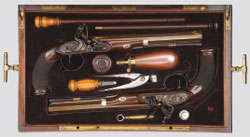
Extraordinarily rare and important pair of cased James Haslet dueling pistols with gold, silver & platinum. Believed to be the finest American flint dueling pistols in private hands. Ex-Renwick, Locke Coll. Frank Sujansky Collection (Est. 75,000- 125,000). James Haslett trained under the Irish gunsmith Robert McCormick, and as a result, brought many of the Irish firearms refinements to America. These pistols feature exuberant gold inlays including sunbursts, feathers, lightning bolts, arrows, and flowers; such elaborate decoration is most unusual on these types of firearms. The Haslets are cased in a very fine quality French fitted walnut case with full accessories.
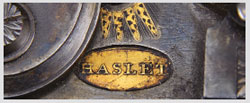
|
Probably one of the greatest icons of Early
American Firearms is the Kentucky long rifle.
These sleek firearms are like a young shapely
maiden; a thing of beauty. Sleek and long
with curves in all the right places, sometimes
ornamented with special embellishments.
They can be admired for the beauty by the
collector and the non-collector.
These long rifles began to evolve in the 18th century. They quickly distanced themselves from all other firearms of the day for not only beauty but also for accuracy. The firearm in the 18th and early 19th century was a means of protection but also a means of obtaining sustenance. Prevailing firearms of the day tended to be the smooth bore muskets that loaded balls with a minimal amount of accuracy. The Kentucky rifle however was very special. Its makers grooved the inside of the barrels with a spiral groove. This groove grasped the bullet and made it spin as it traveled the length of the barrel. This forced spin invested into the bullet, caused it to fly straighter, truer, and longer than a similar bullet shot by a smooth bore musket. Thus its holder could defend himself or herself from an enemy at great distance, long before the enemy was in killing range. In the sustenance department, hunters with Kentucky long rifles were able to bag game at distances much greater than those that used muskets thus increasing their productivity as a hunter. Many makers of the Kentucky rifles went beyond the utilitarian necessities of the gun itself and began to invest a certain amount of extra effort to embellish and beautify the firearms. Inlays within the wood and occasional engravings helped to beautify the arms. Many makers signed their guns, which was of course a great way of promoting themselves and the future sales of their arms. Some however did not and even those that did not sign their rifles today can frequently be identified. Somewhat like an artist that painted with pallet and canvas these gun makers can be identified by certain artistic traits; the style of carving, the quality of carving, the type of brass patchbox, and these with a combination of many other hallmarks created a fingerprint that could narrow down and identify the maker without their signature. The earliest forms of Kentucky rifles of the 18th century had a flintlock ignition system. They consisted of an elongated barrel, a stock, a lock and a patchbox. The lock mechanism had within it a spring device that drove the hammer and the lock was mounted at the very breech of the barrel. The hammer, by means of a small clamp, held a piece of flint and immediately in front of the hammer was a small scooped out pan which was covered by a hinged piece of metal with a flat tongue that stuck straight up. When the hammer was released and sprung forward, the flint struck the steel pan known as a frizzen. The immediate sparks that were formed dropped down into the pan below which was filled with gun powder and thus 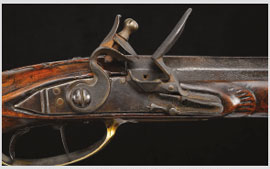
The action of a relief carved York County rifle signed George Shreyer
|
igniting the gun powder. Immediately adjacent
to this scooped out pan was a small hole
drilled into the breach of the barrel known as
the touchhole. Inside the barrel was a charge
of powder, on top of it was a wad and on top
of that a bullet; thus when the gun powder
in the pan was ignited, the immediate flash
and flame carried through the touchhole and
also ignited the powder within the barrel.
The resulting explosion was what drove the
bullet forward and gave it the power to travel
through the air.
Each Kentucky rifle was also fitted with a patchbox. Patchboxes were usually brass, sometimes wood and almost always an identifying factor to the maker. Most makers used their own special artistic flair and creativity to create the cover plate to the patchbox. Some were formed in the shapes of birds or animals or just plain scrolled foliate designs; some were beautifully engraved. A patchbox itself was a small opening in a wooden stock with a spring hinged lid. Within the patchbox, the marksman would store wads, tools, and percussion caps that would be used to recharge his gun. 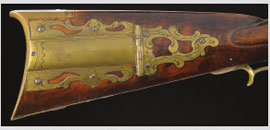
The patchbox of an exceptional relief carved Golden Age
Adam Ernst York County Kentucky rifle
The secret of the gun's accuracy was mentioned before. It was the special rifling in the barrel but in addition to the rifling in the barrel, there was another factor that helped to improve marksmanship for the owner. That factor was the very length of the barrel itself. Guns are fitted with sights; a device to aim the gun. The sights consist of a bead or a blade on the very tip of the end of the barrel and a notched rear sight located at the very breech of the barrel just forward of the shooter's face when the gun was being held. The shooter aligns the blade on the front of his barrel with a very sharp "v" of the rear sight and thus aligns the direction of the barrel and the flight of the bullet. The longer the distance between the front sight and the rear sight, the finer the aim. On the other hand, a similar sight on a short barreled gun means that if the front sight and the rear sight are misaligned by just a slight amount, it can make a tremendous difference in the resulting flight or accuracy of the bullet. Kentucky rifles were almost always prized by their owners and much later by collectors. During their day, the Kentucky rifle was an object that was an important utilitarian object in any household which was passed from father to son to son and thus stayed in the family for generations. In the early part of the 19th century, a new ignition system evolved. One that did not rely upon sparks from flint and steel. The old fashioned flintlock system worked pretty well most of the time but in a driving snowstorm or drenching rain, one's powder could get wet and when you pulled the trigger nothing would happen. In the early 19th century, the percussion ignition system once invented took precedence in the firearms world. But Kentucky rifles with their accuracy were still a treasure to any owner. In the years to come, most nearly all functioning owners of Kentucky rifles would eventually take their gun back to the gunsmith and have the new improved percussion ignition system installed.
|
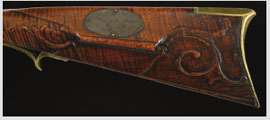
Flintlock relief carved Bedford County Kentucky rifle
attributed to Peter White
Guns that originally had been created with a flintlock system were now converted to a percussion system which made the gun far more functional and usable resulting in continued use of the gun for many years to come. By the 20th century, there were still marksmen and riflemen particularly from Pennsylvania and throughout the Appalachians that still used Kentucky long arms for hunting and for target shooting. Eventually some became intrigued with these arms of beauty and began to collect them. One of the earliest admirers and collectors was a man by the name of Joe Kindig. Joe Kindig became enraptured with Kentucky rifles and over a period of many years, amassed an extraordinary collection of these arms. He not only bought them but he studied them and eventually became the world's reigning authority of Kentucky rifles. It is our good fortune that he elected to document all that he had learned in a form of a large book on the history of Kentucky rifles. This book today still ranks as the "bible" in the Kentucky rifle world and is almost always referenced when speaking of a certain maker. Over the years, Joe Kindig not only collected the guns but eventually began to sell them and through his tremendous passion, his scholarly book, and salesmanship; a fraternity of Kentucky rifle collectors evolved which is now made up of collectors all over North America. Many of these collectors belong to an organization known as the Kentucky Rifleman Association (KRA). The association has meetings, prepares bulletins, scholarly documents and in general promotes the knowledge and the love of these fine old arms. This large band of passionate admirers of the Kentucky long rifle are avid collectors and over the years, the prices of these beautiful guns have risen. It is rumored that in recent past years in a private transaction, one very rare early Kentucky rifle changed hands for approximately $750,000. The majority of all Kentucky rifles however trade hands for a matter of a few thousand dollars usually under $5,000 or $6,000. A good example might be $8-15,000. Rare and more desirable examples might be $15-30,000. A truly rare and/or desirable model might be $30-100,000 and the absolutely stellar examples generally trade hands for $100,000 plus. Some Kentucky rifle makers also made handguns. A handgun was almost a luxury to the frontiersman and very few could afford the extra expense so many long rifle makers never got into making pistols and those that made them usually did not have a huge demand and made far fewer pistols than they did long rifles. Pistols, like long rifles, have special unique characteristics but they are also items of considerable beauty. The earliest ones were made in the 18th century prior to and during the Revolutionary War but the majority of these rare and highly desirable pistols were made in the early 19th century. |
At James D. Julia, Inc. we are always seeking high quality antiques of all types for our year-round auctions. We offer the best seller commission rates in the industry, as low as 0% for high value items and collections. Please contact us directly at 207-453-7125 to learn more or if you are considering consigning one item, an entire collection or an estate to auction. All inquiries are confidential and without obligation.
